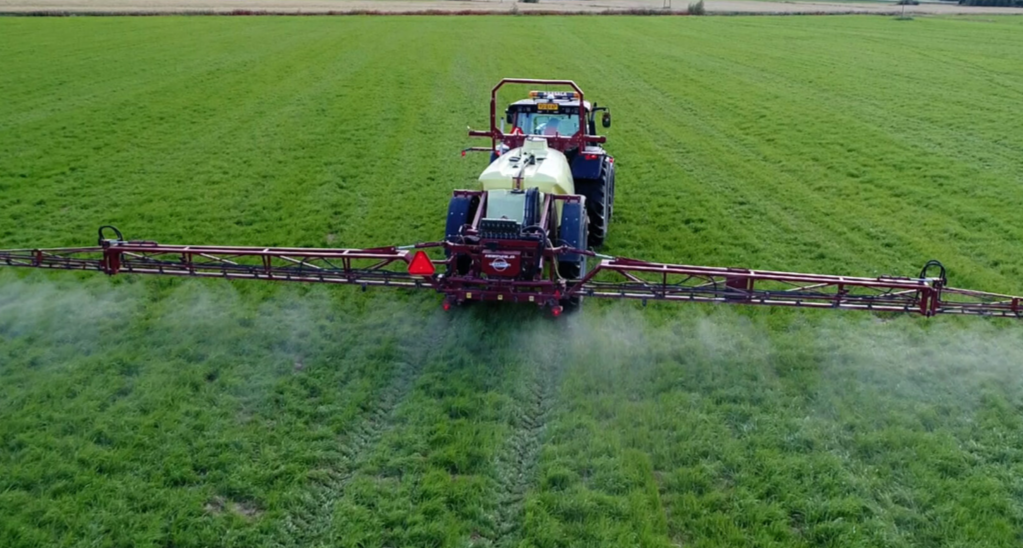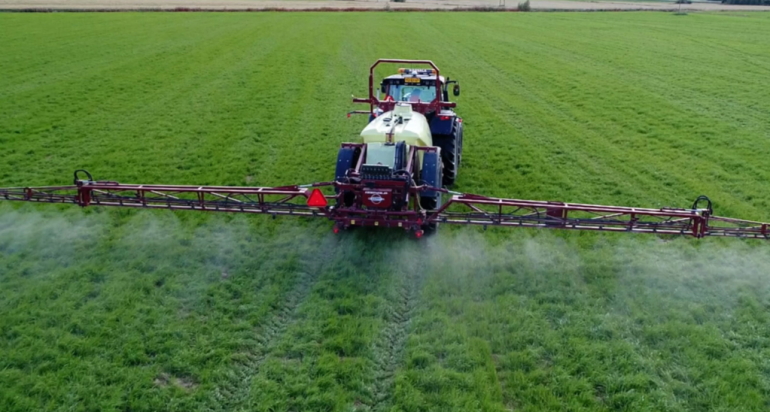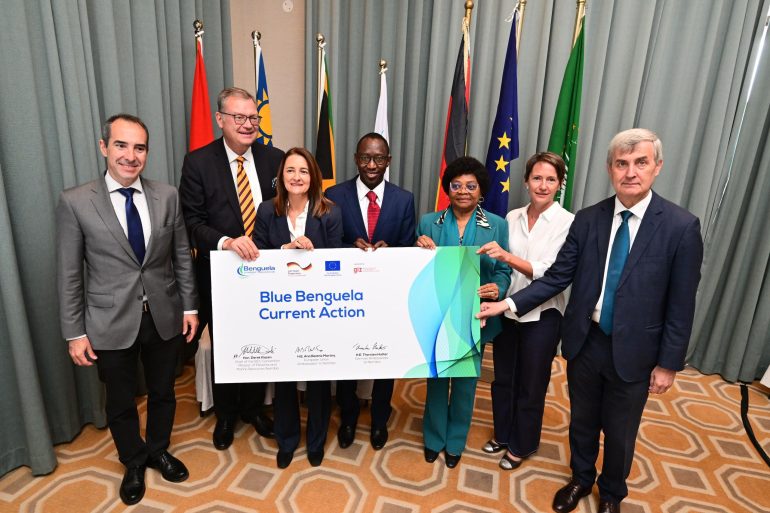Omanyano ovanhu koikundaneki yomalungula kashili paveta, Commisiner Sakaria takunghilile
Veronika Haulenga
Omanyano ovanhu koikundaneki yomalungula kashili paveta, Commisiner Sakaria takunghilile
Veronika Haulenga
Listeners:
Top listeners:
-
play_arrow
Omanyano ovanhu koikundaneki yomalungula kashili paveta, Commisiner Sakaria takunghilile Veronika Haulenga
Lessons from Finland’s attempt to transition to a circular economy


Tracegrow, a Finnish company, uses recycled batteries and industrial waste to create agricultural fertilizers. A number of companies are innovating to increase circular solutions. At the national level, however, experts underline that great challenges remain to advance circularity. Image courtesy of Tracegrow.
By Sean Mowbray via MongaBay
In 2016, Finland became the first country in the world to adopt a national circular economy road map, with the ambition to become a world leader in moving away from an unsustainable “take-make-waste” linear model.
A circular economy stands in contrast to the linear and throwaway model prevalent around the world today. The Finnish Innovation Fund (Sitra), which played an instrumental role in developing the road map, defines the circular economy as “not based on the continual production of more and more goods but on the use of services — sharing, renting and recycling — instead of owning things. Materials are not lost at the end of their useful life but are used to make new products over and over again.”
With the world facing increasing pressure on multiple planetary boundaries deemed vital to maintaining Earth’s “safe operating space,” a circular economy is considered one pathway to reduce overconsumption, slash emissions, and move materials in closed loops. In Finland, pursuing circular solutions has the potential to both cut carbon emissions while also reducing pressure on biodiversity, experts say.
“We are trying to promote an economy that would fit the limits of natural systems,” says Annukka Berg, a circular economy specialist and senior researcher at the Finnish Environment Institute (SYKE). “It would be an economy that consumes a sustainable amount of natural resources, is carbon neutral and is beneficial for nature.”
 Finland was the first country in the world to develop a circular economy roadmap in 2016. Since then, a government program aims to create a “carbon-neutral circular economy society” and has sparked various government measures and innovation from researchers, cities and companies. But these efforts have yet to translate into a decline in material consumption, experts say. Image by French_landscape_photographer via Flickr (CC BY-NC-ND 2.0).
Finland was the first country in the world to develop a circular economy roadmap in 2016. Since then, a government program aims to create a “carbon-neutral circular economy society” and has sparked various government measures and innovation from researchers, cities and companies. But these efforts have yet to translate into a decline in material consumption, experts say. Image by French_landscape_photographer via Flickr (CC BY-NC-ND 2.0).
Finland’s circular ambition
Since the publication of Finland’s road map, the government has laid out plans to transition toward a “carbon-neutral circular economy society” by 2035. Within little more than a decade, the program aims to cap consumption of primary raw materials at 2015 levels (around 217 million metric tons) while doubling material circularity and resource productivity.
Those two ambitions, achieving carbon neutrality and circularity, are deeply linked, according to experts.
“You can reach a certain level of carbon emissions reductions through energy efficiency and a transition to renewable energy,” says Anne Raudaskoski, a circular economy expert and co-founder of Ethica, a Finland-based consultancy service. “But at the end of the day, you do need a plethora of different circular solutions to achieve carbon neutrality.”
But for Finland to achieve its circular economy vision — which involves reworking whole sectors such as forestry, agriculture, construction and transport — will be a tall task, according to experts, as the country’s roughly 5.5 million people have one of the largest material footprints per capita in Europe. In 2021, Finland’s domestic material consumption stood at 245 million metric tons, or 44 metric tons per person — far higher than the European Union’s average of 14.5 metric tons per capita.
But at the EU level, circular economy efforts are stalling.
 Implementing the circular economy comes with its own challenges. A study published earlier this year shows that striving to improve circularity in some sectors of the Finnish economy, such as using greater volumes of wood in construction to replace steel and concrete, could provoke unforeseen impacts on biodiversity, underlining the need for greater research on the potential ecological consequences of this shift. Image by Ninara via Flickr (CC BY 2.0).
Implementing the circular economy comes with its own challenges. A study published earlier this year shows that striving to improve circularity in some sectors of the Finnish economy, such as using greater volumes of wood in construction to replace steel and concrete, could provoke unforeseen impacts on biodiversity, underlining the need for greater research on the potential ecological consequences of this shift. Image by Ninara via Flickr (CC BY 2.0).
“Overall, we concluded that there is only limited evidence that the Circular Economy Action Plans, and in particular the actions regarding the circular design of products and of production processes, had influenced circular-economy activities in the member states,” reads a report by the European Court of Auditors.
Though some countries are progressing slowly, Finland’s circularity efforts took a step back between 2010 and 2021. In 2018, for example, Finland’s circular material use was around 7%, and two years later it fell to 4.5%.
Still, some experts say Finland could set its ambitions far higher.
“We don’t actually know … what those sustainable levels of resource use would be,” Berg says. She says analysis by her institute estimates that sustainable levels of resource use in Finland may actually be around one-third of 2015 levels. “It’s not an ambitious target, but it’s a ceiling.”
 Lappeenranta-Lahti University of Technology’s Lappeenranta campus. Experts say that education and research, alongside policy, innovation and cross-sector collaboration, is key to driving forward the circular economy. “By means of tailored education programs, such as MSc Programme in Circular Economy, we educate experts who have capacity to lead the change toward circular economy in very different organizations,” says Jarkko Levänen, who heads up the university’s circular economy master’s degree program. Image courtesy of Lappeenranta-Lahti University of Technology.
Lappeenranta-Lahti University of Technology’s Lappeenranta campus. Experts say that education and research, alongside policy, innovation and cross-sector collaboration, is key to driving forward the circular economy. “By means of tailored education programs, such as MSc Programme in Circular Economy, we educate experts who have capacity to lead the change toward circular economy in very different organizations,” says Jarkko Levänen, who heads up the university’s circular economy master’s degree program. Image courtesy of Lappeenranta-Lahti University of Technology.
Achieving a sustainable and circular economy
To achieve the country’s circular goals, current high-level efforts are focused around a Circular Economy Green Deal that’s part of the government’s strategic program. It involves a wide collaboration of around 90 stakeholders, including government, local municipalities, companies and others, with the ultimate aim of creating a voluntary initiative to drive circularity forward.
“We are looking at the data and producing scenarios for 2035 to understand how the use of material develops and how it can diminish so we reach those targets we set two years ago,” says Taina Nikula, senior ministerial adviser at the Ministry of Environment. “The idea is that cities, local governments, businesses, and other stakeholders reach a consensus on a Green Deal for Circular Economy so that they set their own targets.”
As part of that process, research institutions led by SYKE published draft scenarios outlining the possible outcomes of circular economy actions in Finland. The report indicates that Finland’s goal to double levels of circularity by 2035 can be achieved somewhat easily, Berg says. Yet efforts to double resource productivity are proving more complex, as Finland’s consumption of raw materials will likely remain high, meaning that more ambition is needed to reach circular objectives. The full results will be published in early 2024.
Positively, it also indicates that circular economy and carbon neutrality measures are better for the economy and Finland’s GDP, Berg says.
“The scenarios bring more scientific robustness to circular economy policy in Finland,” she says, a point that in her view has been lacking.
 Betolar, a Finnish company, has developed a method to reduce carbon emissions linked to cement production by up to 80% in some cases. By using industrial side streams, such as blast furnace slag from steel production, and mixing them with an activator, the company produces alkali-activated materials they name GeoPrime. “You get this really strong binder that has the same or even better properties than cement,” says Melina Pinomaa, sustainability manager at Betolar. “Long term, we really enable a viable way to decarbonize the cement and concrete industry.” Image courtesy of Janne Mikkilä/Betolar.
Betolar, a Finnish company, has developed a method to reduce carbon emissions linked to cement production by up to 80% in some cases. By using industrial side streams, such as blast furnace slag from steel production, and mixing them with an activator, the company produces alkali-activated materials they name GeoPrime. “You get this really strong binder that has the same or even better properties than cement,” says Melina Pinomaa, sustainability manager at Betolar. “Long term, we really enable a viable way to decarbonize the cement and concrete industry.” Image courtesy of Janne Mikkilä/Betolar.
Experts say more regulation and specific policies supporting circular economy solutions are needed, focusing on raw material extraction, for example, in addition to legislative measures already taken, such as a waste and landfill taxes.
“Voluntary actions can provide a valuable contribution, but we also need to change the rules of the game, especially if we are to go beyond just capping our resource use at current levels,” says Tim Forslund, a circular economy expert with Sitra. “In particular, we still need much stronger market-based instruments to help deliver the necessary shifts.”
Nikula says other policy tools, such as taxation and economic incentives, are still under discussion. But she adds that “we are trying this voluntary approach because it’s not just legislation that pushes forward change, we need innovation from different stakeholders.”
 Finland is also looking at bio-based solutions to reduce reliance on petrochemicals and fossil-based plastics. Innomost, for example, produces chemical products destined for the cosmetic industry from birch bark, a waste stream from the forestry industry, which is commonly burned for energy. “If you think about it, that’s the minimum use of that material,” says founder and CEO Sami Selkälä. By extracting ingredients from the bark, he says, the current reliance on other feedstocks, such as fossil fuels and palm oil, can be reduced and a “higher value” gained from the bark. Image courtesy of Innomost.
Finland is also looking at bio-based solutions to reduce reliance on petrochemicals and fossil-based plastics. Innomost, for example, produces chemical products destined for the cosmetic industry from birch bark, a waste stream from the forestry industry, which is commonly burned for energy. “If you think about it, that’s the minimum use of that material,” says founder and CEO Sami Selkälä. By extracting ingredients from the bark, he says, the current reliance on other feedstocks, such as fossil fuels and palm oil, can be reduced and a “higher value” gained from the bark. Image courtesy of Innomost.
Mainstreaming circularity and innovation
Current efforts may be bearing fruit: there’s evidence that the Finnish people are becoming more aware of the idea of a circular economy. Preliminary results of a barometer exercise led by the Finnish Environment Institute found there’s familiarity with the concepts of the circular economy after surveying nearly 1,000 citizens and 500 business representatives.
“It basically shows that circular economy is becoming a term and a concept that people understand quite well [in Finland],” Nikula says. However, Tiina Karppinen, a researcher with SYKE, says most respondents were aware of the so-called outer rings of a circular economy, such as recycling and waste management. Awareness of the inner rings — the “crucial and more fundamental” aspects of circularity, such as repair, product longevity, circular design, and reduction of material use — was lagging behind, Karppinen says.
“Overall, I think this is a problem that we are still struggling to tackle,” she adds.
A host of pilot projects are under way to find circular solutions in Finland across multiple sectors. Sitra, for example, tracks dozens of circular economy solutions, ranging from companies looking to advance the sharing economy, to solutions that address plastic waste. Experts highlight some examples, such as Verso Food, which offers alternative sources of protein made from fava beans, and Järki Särki, a company bringing an overlooked fish species, the common roach (Rutilus rutilus), to the market.
In line with Finland’s ambition to create a circular bioeconomy, other companies are developing solutions to reduce fossil-fuel based plastic use by using renewable resources and byproducts of the timber industry. Others are creating chemicals and textile fibers from wood materials. According to Sitra, “biomass obtained from forests will be used more and more in textile fabrics, plastics, cosmetics, medicines, chemicals and smart packaging” in Finland.
 Finland has set targets to increase the use of wood in construction. Forty-five percent of buildings will include wood by 2025. “We can design the buildings so that we less material or use low-carbon material and then think about increasing the life cycle of the building, make it easy to change or repair and maybe reuse building components at the end of life,” says Ali Amiri, a researcher at Aalto University. Image courtesy of Ali Amiri.
Finland has set targets to increase the use of wood in construction. Forty-five percent of buildings will include wood by 2025. “We can design the buildings so that we less material or use low-carbon material and then think about increasing the life cycle of the building, make it easy to change or repair and maybe reuse building components at the end of life,” says Ali Amiri, a researcher at Aalto University. Image courtesy of Ali Amiri.
 Cities in Finland, such as Turku, have produced their own circular economy road maps. Turku’s areas of focus include energy, food, water, construction and transport. Taina Nikula, with the Ministry of Environment, says innovate public procurement has a key role to play in establishing circularity at the local level. “[Cities] can direct the way enterprises are designing their services and products, because they have this purchasing power,” she says. Image by Markus Koljonen via Wikimedia Commons (CC BY-SA 3.0).
Cities in Finland, such as Turku, have produced their own circular economy road maps. Turku’s areas of focus include energy, food, water, construction and transport. Taina Nikula, with the Ministry of Environment, says innovate public procurement has a key role to play in establishing circularity at the local level. “[Cities] can direct the way enterprises are designing their services and products, because they have this purchasing power,” she says. Image by Markus Koljonen via Wikimedia Commons (CC BY-SA 3.0).
Efforts to increase circularity in the country’s textile industry illustrates some of the challenges. In 2019, Finland produced around 80,000 metric tons of textile waste, more than half of which was incinerated. In 2023, a law came into force requiring the separate collection of textile waste, in line with an EU directive to increase recycling.
“Without the feedstock and somebody collecting and sorting all the different materials, we cannot get to textile circularity,” says Anna Garten, a post-consumer textiles expert with Lounais-Suomen Jätehuolto, a municipal waste management company.
She says markets also still need to be developed for recovered and mechanically recycled textiles.
“What’s even more important is that we design products which last in the use that they were designed for as long as possible,” she adds.
Finland’s reliance on imported textiles complicates efforts to create a circular economy in this sector, according to Anna-Kaisa Huttunen, director of partnerships at Rester. Her company takes end-of-life textiles from businesses and breaks them down into fibers that can be used as yarn for clothing or a range of industrial applications, such as insulation. She agrees that current designs and recycling technology limit the amount of “closed-loop solutions,” which aim to return textiles to their original use.
“There are a lot of good innovations in Finland, as well as in other Nordic countries, for new bio-based and fully circular materials,” Huttunen says. “But it will take quite some time before those fibers are at a scalable commercial level.”
One of the key lessons from Finland’s circular venture is that solutions should focus on root causes of sustainability problems rather than tackling the “easily observable surface-level problems,” says Jarrko Levänen, associate professor at Lappeenranta-Lahti University of Technology.
Developing technologies to increase textile circularity is important, but, Levänen says, “it is even more important to address simultaneously the overconsumption of textiles, which is the root problem at that sector.”
 Finland has produced innovative solutions seeking to increase circularity in the textile sector. For example, a pilot project incentivizing textile collection in the city of Lahti claimed a 500% increase in recycling rates. Companies such as Spinnova are adopting methods that use renewable resources, such as wood. Other circular solutions, including expanding markets for recycled materials, increasing circularity in design, and reducing consumption, are required, experts say. Image courtesy of Lounais-Suomen Jätehuolto.
Finland has produced innovative solutions seeking to increase circularity in the textile sector. For example, a pilot project incentivizing textile collection in the city of Lahti claimed a 500% increase in recycling rates. Companies such as Spinnova are adopting methods that use renewable resources, such as wood. Other circular solutions, including expanding markets for recycled materials, increasing circularity in design, and reducing consumption, are required, experts say. Image courtesy of Lounais-Suomen Jätehuolto.
Lessons from Finland
Collaboration and inclusion of multiple stakeholders — from government, cities, businesses both large and small, and researchers — across the board has been crucial to building a platform to promote the circular economy in Finland, according to experts.
Similarly, setting clear targets, even if lacking in major ambition, has underpinned the process thus far.
“You do need an ambitious vision. You do need a strategy or road map. But you do need to have numeric targets,” says Raudaskoski from the consultancy Ethica. “Otherwise, there’s this danger it will only be about presentations and speeches, but not real action.”
It’s equally important those targets are based on “robust” scientific evidence, says Berg from SYKE.
A key lesson from Finland, says Sitra’s Forslund, is the importance of education. Early on, the innovation fund partnered with research institutions to develop circular economy learning modules.
“If we want a kind of systemic shift, then we need to really work with education and circular economy,” he says. “In many fields the transition to new practices is so big that it requires completely new skills and capabilities from different actors.”
 Finland aims to be a leader in the production of bio-based plastics. Local company Woodly is using wood cellulose to produce packaging and replace fossil fuel-based plastics. According to company CEO Jaakko Kaminen, the company’s material is both carbon neutral and designed to be recycled with existing infrastructure. Today, the bio-based content of Woodly products is around 40-60%, he says, with the goal of achieving 80-100% by 2025. Image courtesy of Woodly.
Finland aims to be a leader in the production of bio-based plastics. Local company Woodly is using wood cellulose to produce packaging and replace fossil fuel-based plastics. According to company CEO Jaakko Kaminen, the company’s material is both carbon neutral and designed to be recycled with existing infrastructure. Today, the bio-based content of Woodly products is around 40-60%, he says, with the goal of achieving 80-100% by 2025. Image courtesy of Woodly.
Levänen, who heads up a circular economy master’s degree course at Lappeenranta-Lahti University of Technology, cites the course as among the university’s “most popular offerings.”
But the pace of Finland’s transition is still too slow, he says. “Industries would need more concrete incentives to accelerate their change. When a critical mass of companies start to change their practices, it forces all other to take action as well,” he says.
Since it began in 2016, Finland’s circular economy venture has spread seeds of sustainability, say experts, though vast challenges remain to be resolved if they’re to bear fruit by the 2035 deadline.
Written by: Contributed
biodiversity circular economy Climate Change Climate Crisis Conservation Finland Recycling Reusing
Similar posts
Windhoek Weather
Most popular

Namdia Heist: More questions, lots of confusion

Omuhwahwameki Michael okuunganeka oshikonga shoku patitha oostola dho Rani moshilongo ashihe.

Walvis Bay woman loses over N$777.000 to a fraudster

Don’t let Pohamba’s tears over Nujoma’s death go to waste

Justice Served: Jandre Dippenaar Found Guilty of Six Murders in Swakopmund Court
Copyright 2025 Future Media (Pty) Ltd | Website by Digital Platforms
Tel: +264 83 000 1000 | Email: news@futuremedia.com.na





